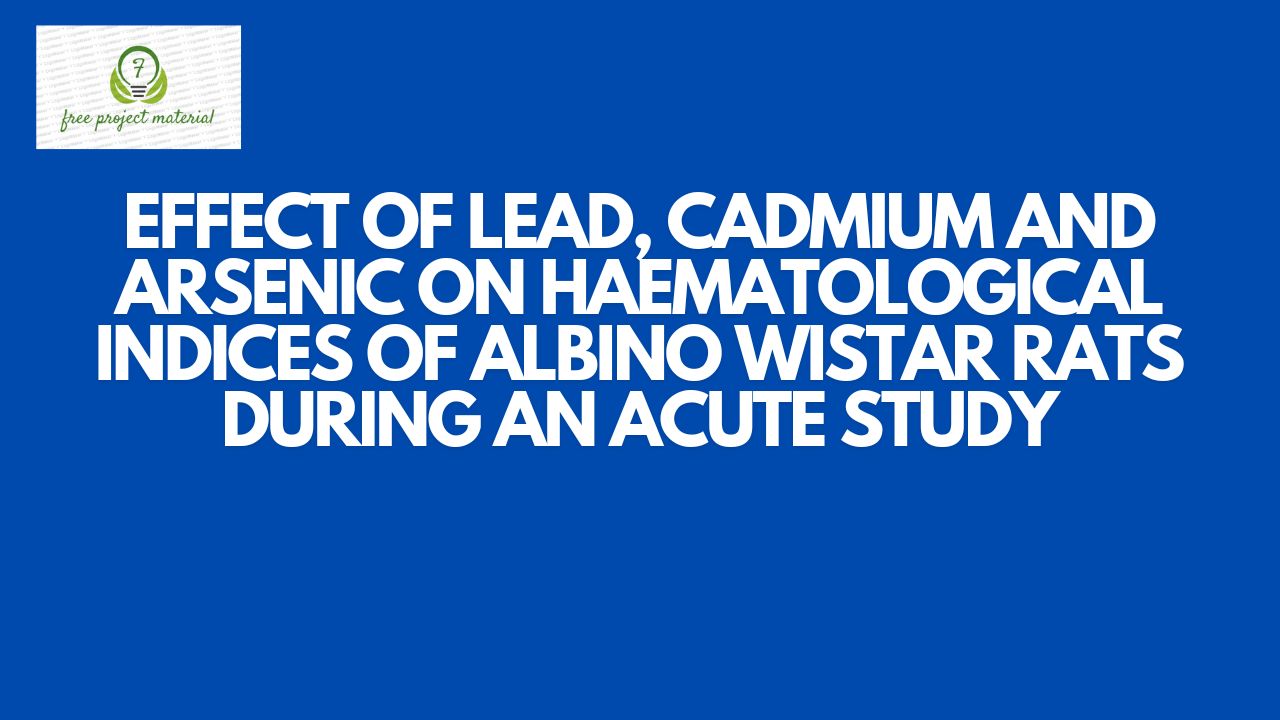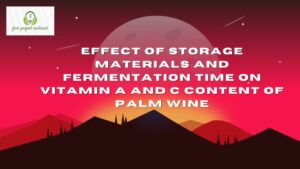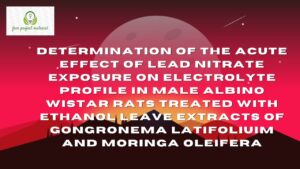ABSTRACTS
Lead, cadmium and arsenic are commonly available in nature and their toxicity has become an epidemiological issue as such this study was carried out to determine the effect of acute lead, cadmium and arsenic exposure on haematological parameters in albino wistar rats. In this study twenty five (25) male albino wistar rats were randomly assigned to five groups with five rats in each group. Group 1 served as the control, group 2 was administered with 120mg/kg body weight of lead, group 3 was given 45mg/kg body weight of cadmium, group 4 was administered with 37.6mg/kg bodyweight of arsenic and group 5 was given a combination of the three heavy metals in the concentration indicated above. The result of the analysis indicate a significant decrease (p<0.05) of RBC, HGB, PCV in the treated groups when compared to the control. There was a significant increase of WBC in the treated groups except with group 4 when compared to the control group there was no significant change in MCV, MCH and MCHC between the control group and the treated groups. This therefore suggests that heavy metals toxicity could lead to anemic conditions as well as bone problems and has a potential of weakening the immune system.
TABLE OF CONTENTS
PAGES
TITLE PAGE – – – – – – – – i
CERTIFICATION – – – – – – – ii
DEDICATION – – – – – – – – iii
ACKNOWLEDGEMENT – – – – – – iv
ABSTRACT – – – – – – – – v
TABLE OF CONTENTS – – – – – – vi-x
CHAPTER ONE
INTRODUCTION
1.1 Background of the Study – – – – – 1-5
1.2 Aim and Objectives of the Study – – – – 5
1.2.1 Aim of the Study – – – – – – – 5
1.2.2 Objectives of the Study – – – – – – 5-6
1.3 Scope and Limitation of the Study – – – – 6
1.3.1 Scope of the Study – – – – – – 6
1.3.2 Limitation of the Study – – – – – – 6-7
1.4 Definition of Terms – – – – – – 7
CHAPTER TWO
LITERATURE REVIEW
2.1 Overview of Heavy Metals – – – – – 8-9
2.1.1 Lead – – – – – – – – – 9-10
2.1.2 Cadmium – – – – – – – – 10-11
2.1.3 Arsenic – – – – – – – – 11-12
2.2 Mechanism of Heavy Metals Toxicity – – – 13
2.2.1 Mechanism of Arsenic Toxicity – – – – 13-15
2.2.2 Mechanism of Cadmium Toxicity – – – 15
2.2.3 Mechanism of Lead Toxicity – – – – – 16-17
2.3 Health Effects of Heavy Metals Toxicity – – – 17
2.3.1 Health Effects of Arsenic Toxicity – – – – 17-18
2.3.2 Health Effect of Lead Toxicity – – – – – 19-19
2.3.3 Health Effect of Cadmium Toxicity – – – – 19-20
2.4 Haematological Parameters – – – – – 20-21
2.4.1 Red Blood Cell Count – – – – – – 21-22
2.4.2 Packed cell Volume – – – – – – 22-23
2.4.3 Mean Corpuscular Volume (MCV) – – – – 23-24
2.4.4 Haemoglobin (Hb) – – – – – – 24-25
2.4.5 Mean Corpuscular Haemoglobin – – – – 25-26
2.4.6 Mean Corpuscular Haemoglobin Concentration – – 26
2.4.7 White Blood Cell (WBC) – – – – – 27-28
2.5 Review of the Effects of Cadmium, Lead
and Arsenic in Hematological Parameters – – – 28-30
CHAPTR THREE
MATERIALS AND METHOD
3.1 Materials and Reagents – – – – – – 31
3.2 Methods – – – – – – – – 31
3.2.1 Procurement of Heavy Metals – – – – 31
3.2.2 Preparation of Heavy Metals – – – – – 32
3.2.3 Animal Grouping and Treatment – – – – 32-33
3.2.4 Collection of Blood Sample – – – – – 33
3.2.5 Determination of Some Haematological Parameter – 34-35
3.3 Statistical Analysis – – – – – – 36
CHAPTER FOUR
RESULT AND DISCUSSION
4.1 Result – – – – – – – 37-41
4.2 Discussion – – – – – – – 41-45
CHAPTER FIVE
CONCLUSION AND REMMENDATION
5.1 Conclusion – – – – – – 46
5.2 Recommendation – – – – – 47
References
CHAPTER ONE
INTRODUCTION
1.1 Background of the Study
Due to the industrial revolution and the use of heavy metals in the production of many industrial products, heavy metals are no ubiquitous in various forms in the environment. Primarily human beings and animals are intoxicated by mean of consumption of contaminated foods, contaminated water, mining, battery recycling and plastics. Due to being the major route of excretion from the body, kidneys are more vulnerable to heavy metals toxicity, mostly of lead (Pb), cadmium (Cd), mercury (Hg), and arsenic (As). Depending on the duration and dose size (low or high),numerous fetal effects have been reported in blood composition, lung and brain. In general, removal of patient from the site is the provision to treat toxicity. Depending dose size and severity of the condition, different antidotes and chelating agents are prescribed. But, these agents interferes with essential metals ions like Ca2+, Cu2+, Zn2+ and results in aberrant physiologic functions (Aposhian et al., 1995).
Arsenic is predominantly present in water, soil and air from natural and anthropogenic sources, however, drinking of contaminated water I is the main cause of acute and chronic adverse health effects in humans (Flora, 2011). Epidemiological studies have suggested a strong correlation between chronic arsenic exposure and various human diseases such as hyperkeratosis,, atherosclerosis, diabetes, obstructive pulmonary diseases (Flora, 2011). Long term arsenic exposure has also been linked to cancer of skin, lung, colon and rectal (Zhang et al., 2011).
Lead is a widespread natural elements in the environment. It is considered as one of the main persistent and common environmental pollutants/. Lead is used in the production of various manufactured products such as paints, printing, gasoline batteries, water pipes, cosmetics and toys. Owing to its toxic cumulative actin in the environment. Lead can affect all biological systems via exposure from different sources including air, water and foods (Harbison, 1998). Lead enters into the body through three main routes, including digestive tracts, respiratory tracts and skin, when it is absorbed into the blood, some of it is bound to erythrocytes, and the remaining stays in plasma to be distributed to others tissues. There are many evidence that reports that lead is a poisonous factor, which targets numerous organs such as kidneys, liver, nervous system, immune system and hematopoietic system (Duruibe et al., 2007).
Cadmium has no known biological functions and cause many diseases when accumulated in the excessive exposure can cause death, it enters cells and accumulated in high concentrations in cytoplasmic and nuclear space, it has been observed that to have a high affinity from the liver and kidneys (Cai et al., 2001). Cadmium is a non-essential toxic elements which enters the body via a number of routes including foods, water , air and by smoking of cigarrete. In the blood it is mainly accumulated in the red blood cells and binds to a low molecular weight protein called metallothionein. Metallothionein plays a major role in homeostasis of cadmium. More than 80% if cadmium I bound to metallotheonein and found in the liver and kidney, it is now widely thought that metallothionein is protective against cadmium toxicity and that intracellular cadmium bound to metallothionein is non-toxic (Nordberg, 2001). It has been reported that pretreatment of experimental animals with small doses if cadmium prevent acute toxic effects of large doses of cadmium. Acute cadmium poisoning may produce degenerative changes in renal tubular cells (Goyer, 1998).
Haematology refers to the study of the numbers and morphology of the cellular elements of the blood, haematological studies are useful in the diagnosis of many diseases as well as investigation of the extent of damage to blood . blood is a vital special circulatory tissue composed of cells suspended in a fluid intracellular substance (plasma) with the major functions of maintaining homeostasis. Heamatological component consist of red blood cells, white blood cells or leukocytes, mean corpuscular volume, platelet etc. (Isaac et al., 2013). Blood is one of the most important tissue, in which changes in metabolic processes are reflected, therefore, abnormal alteration in blood parameters are the reliable indicators of toxic effects of drugs, chemicals and diseases.
Lead, cadmium and arsenic has been recognized as a biological toxicant. They are widely dispersed in the environment and are with excessive level, toxic to humans. Absorbed cadmium, lead and arsenic are carried via blood to soft tissues. In this regard, the present study was designed to evaluate the effects of cadmium, lead and arsenic and their combination on the haematological parameters of albino wistar rats.
1.2 Aim and Objectives of the Study
1.2.1 Aim of the Study
The aim of this study was to evaluate the effect of acute cadmium, lead and arsenic exposure on haematological parameters of albino wistar rats.
1.2.2 Objectives of the Study
The specific objectives of this study was to determine the effect of acute exposure on haematological indices.
To compare the haematological parameters of treated groups with control so as to draw useful conclusion.
To examine the effect of acute cadmium exposure on haematological parameters.
Assess the effect of acute arsenic exposure on haematological parameters.
Determine the effect of co-exposure I to lead, cadmium and arsenic on haematological parameters.
1.3 Scope and Limitation of the Study
1.3.1 Scope of the Study
The scope of this study only covers the effect of acute lead, cadmium and arsenic exposure in the haematological parameters of albino wistar rats
1.3.2 Limitation of the Study
The limitation encountered during the course of this study were:
- Time constraints.
- Financial constraints lack of adequate amenities in the school environment to enable easy work.
- Poor power supply.
1.4 Definition of Terms
Exposure: the condition if being exposed, uncovered or unprotected from.to something.
Effect: the result or outcome of a course.
Acute: a short, Sudden or shot-lived condition.
Haematology: the branch of medicine that lead s with the diagnosis and treatment of disease of the blood and bone marrow.
Heavy metals: are metals with relatively high densities, atomic weights or atomic number.



